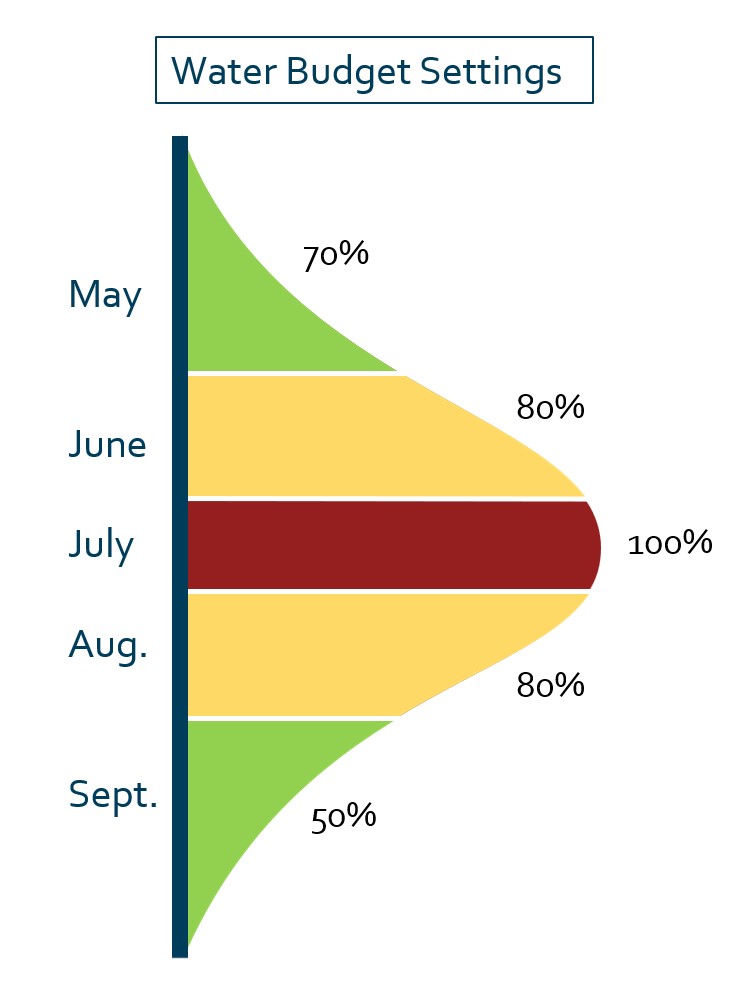Residential irrigation
The number one way to save water in Kelowna is to ensure that your automatic irrigation systems are operating efficiently. Irrigation experts estimate that homeowners can reduce outdoor watering needs by 25 per cent just by keeping up with irrigation system maintenance and setting the timer properly.
- Group irrigation circuits/zones into “hydrozones” of high, medium and low or unirrigated areas consistent with the landscape planting plan
- Use reclaimed or recycled water, or rainwater captured from roofs or rain barrels, for outdoor water use - when available - as a substitute for potable water. It’s not the intent of this guideline to require a development to produce recycled water or install rainwater systems only for irrigation purposes.
- Minimize the use of high-volume spray heads and employ drip or low-volume irrigation where practical to meet the watering needs of hydrozones
- Use surface or subsurface drip irrigation or low volume irrigation technology to water long, narrow or irregularly shaped areas, including turf areas less than 2.4 metres in width
- Use a smart controller that adjusts watering times automatically to changing weather
- Ensure landscape and irrigation design, and installation standards including adjustments and irrigation scheduling, meet irrigation specifications – consider the City specifications as a standard of best practice, or use specifications at a similar level of detail provided by a qualified professional
Our Water Smart program offers free irrigation system assessments. A Water Smart Assessment will take approximately one hour for single family homes and more for strata complexes. During the WSA, a Kelowna Water Smart team member will operate your irrigation system, looking for any issues and opportunities to reduce irrigation water use. The more you know, the more efficient your system can become.
BOOK FREE IRRIGATION ASSESSMENT
A Water Smart team member will operate your irrigation system and look for issues and opportunities. Some areas that will be looked at include:
Sprinkler heads are susceptible to damage and can deteriorate over time. Since most systems are operated while we sleep, broken heads often go unnoticed.
Wind, slopes, mismatched heads and pressure changes can lead to uneven water distribution with some areas being too wet and other areas too dry. There are often minor adjustments that can be made to your system to improve the Distribution Uniformity and reduce irrigation water use.
Rotating spray heads move back and forth while fixed spray heads are stationary. This means that a fixed head will deliver water faster than a rotating sprinkler. Industry best practices is to not have different types of sprinklers on the same zone. Reviewing your zones can help find mixed zones and look for solutions.
When you make changes to landscapes over time, best practice is to explore whether the existing irrigation equipment works well with the new landscape material and if it doesn’t, to make adjustments. The Water Smart Assessment can help determine if you have zones such as this and if so, they can offer suggestions to help reduce water, reduce costs and make your plants happier and healthier.
Train your yard to be more drought tolerant. Plants and grass don't need nearly as much water in Spring and late Summer so consider adjusting your irrigation controller to match the water budget of the season.

Need help with that? Contact us to assist you with your irrigation controller programming.
Rainfall and temperature impact the actual monthly requirements of irrigating your lawn (and other plant materials). A rain sensor or rain switch is a water conservation device connected to an automatic irrigation system that causes the system to shut down in the event of rainfall.
Installing a rain senor or other device for monitoring on-site conditions will provide you with valuable information that will help you irrigate to meet the needs of your landscape. Rain sensors can be purchased at most hardware stores across Kelowna.
| May/June | July/August | September/October |
Inches of water per week | 0.8" | 1" | 0.6" |
Inches of water per month | 3.2" | 4" | 2.4" |
The City Water Utility requires its customers (on residential and commercial properties) to complete a Landscape Water Conservation Report before installing a new irrigation system. These requirements are specified within the Water Regulation Bylaw for the City Water Utility area (specifically section 4.4 and schedule C).
Completing the Landscape Water Conservation Report is necessary to ensure that the landscape design and the irrigation design work together to achieve water efficiency.
- Landscape area includes any area that will absorb water: lawn, plantings and mulch areas. It also includes pervious paving or pervious decks.
- Include the absorbent parts of the boulevard between the property line and the street
- Don’t include areas that won’t absorb water: buildings, impervious driveways or walks
- Divide your landscape into areas with similar water needs. These hydrozones can be no-water zones, or areas with low-to-high-water needs. Sketching out a simple diagram might help you.
- Consider microclimates: areas of your yard with different sun/wind exposure
- Determine the area (in square meters) of each hydrozone; you will need these numbers to complete the application. The sum of hydrozone areas must equal the total landscape area.
Download the Landscape Water Conservation Report (.xls).
- On the first page of the workbook, enter the details about your project and check off the irrigation system requirements.
- On the second page, enter the total landscaped area as well as the areas of the individual hydrozones in the yellow highlighted areas
- The spreadsheet automatically calculates the landscape maximum water budget (WB) and the estimated landscape water use (WU), and the difference between them.
- WB: calculated annual water use if 100 per cent of the landscape area was irrigated lawn
- WU: estimated annual water use for irrigating the landscape based on your design
- The calculated difference between the WB and the WU is displayed as either a red or a blue number on the third page of the application.
- Red number: indicates that your landscape/irrigation design is not water efficient
- Blue number: means it’s ok to submit your application
- The goal is to reduce the WU of your landscape design below the WB. Try different designs to see which one results in more water saved.
- Once you’re satisfied with your final design and calculated water use, save your application using the project address for the name (ex: 1435WaterStreet.xls).
- Email the application to [email protected]
- You should get a reply within 48 hours about the status of your application
The Water Regulation Bylaw was adopted to conserve water and support our commitment to sustainability. The bylaw applies to all residential dwellings serviced by the City Water Utility installing new irrigated landscape material comprising of an area of 100 square meters. Irrigation for farm status properties are exempt.
Find your water provider to find out of if the bylaw applies to you.
Every new irrigation system must be installed with an outdoor irrigation master shut off valve outside the building that’s accessible to the City, and an irrigation controller that can be programmed by day of week. See Water Regulation bylaw, section 4.4.10.
A backflow protection device (dual check valve for residential) is required for irrigation connections. A plumbing permit is required for the backflow protection device.



